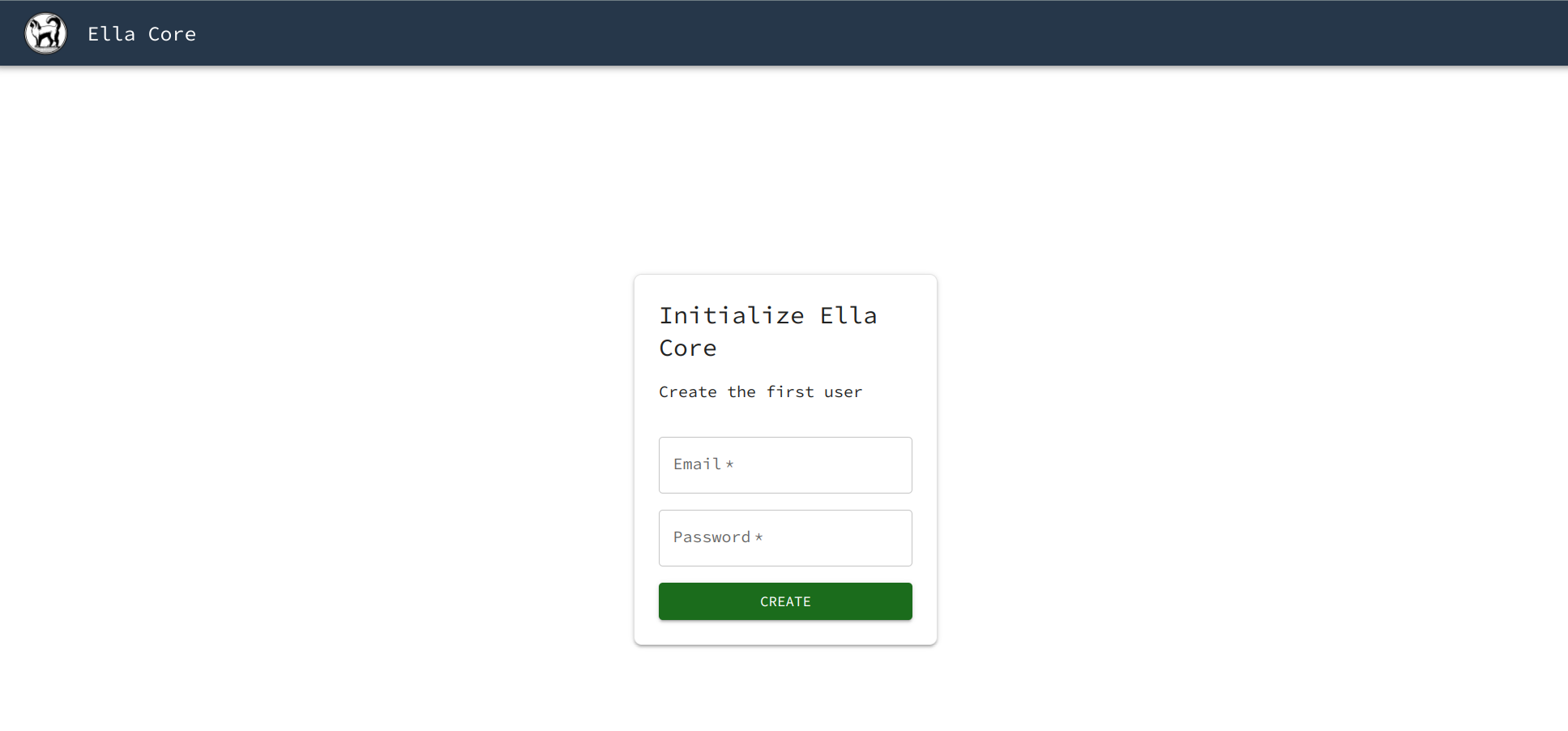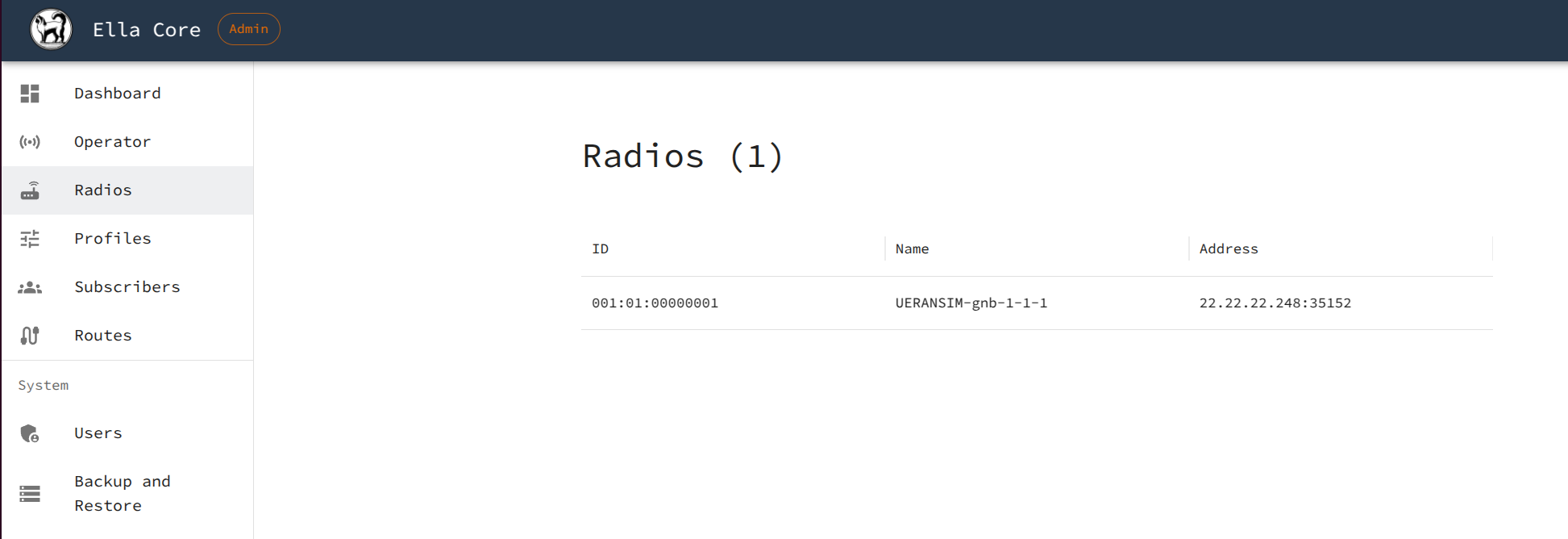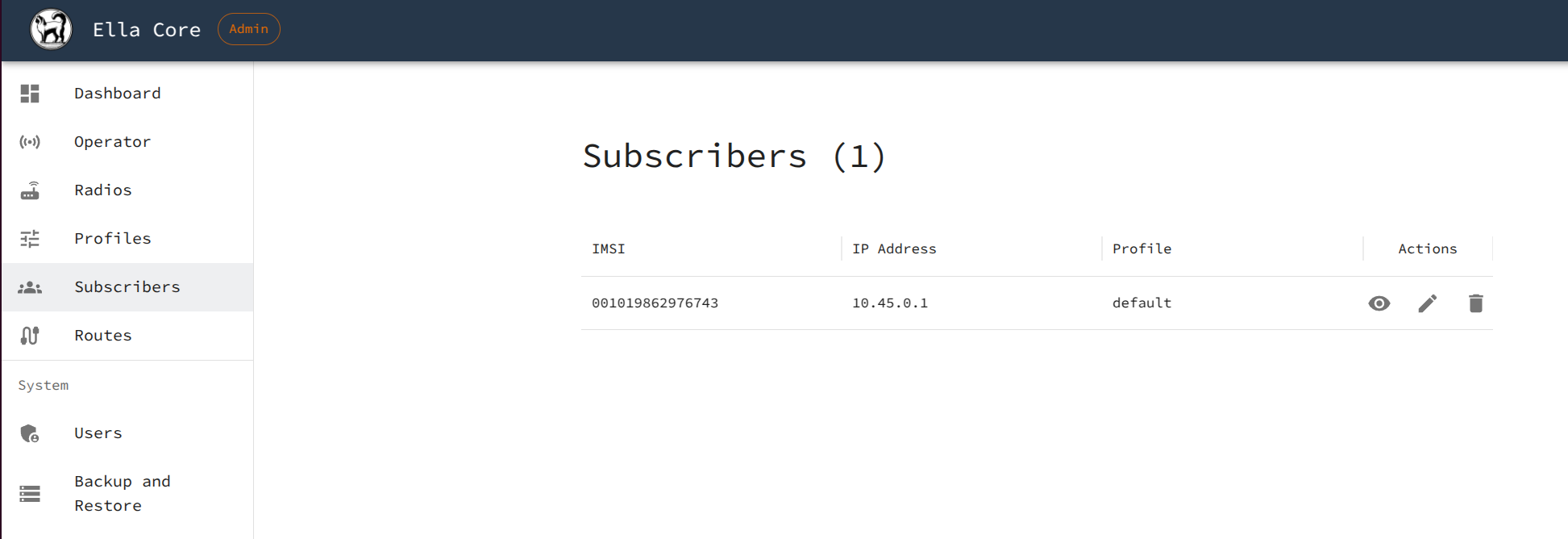Running an End-to-End 5G Network with Ella Core¶
In this tutorial, we will deploy, initialize, and configure Ella Core, an open-source 5G mobile core network. First, we will install Ella Core and UERANSIM (a 5G radio and User Equipment simulator). Then we will access Ella Core's UI and configure a network subscriber. Finally, we will start the 5G radio and user equipment simulators, and validate that the subscriber connects to the network and that it can use this connection to access the internet.
You can expect to spend about 10 minutes completing this tutorial.
Pre-requisites¶
To complete this tutorial, you will need a Linux machine with Docker installed.
1. Install Ella Core and UERANSIM¶
Create a new directory for this tutorial and navigate into it:
mkdir ella
cd ella
Copy the following file into this directory:
services:
ella-core:
image: ghcr.io/ellanetworks/ella-core:v0.4.1
restart: unless-stopped
entrypoint: /bin/core --config /core.yaml
volumes:
- /sys/fs/bpf:/sys/fs/bpf:rw
privileged: true
ports:
- "5002:5002"
networks:
default:
driver_opts:
com.docker.network.endpoint.ifname: eth0
n3:
driver_opts:
com.docker.network.endpoint.ifname: n3
ipv4_address: 10.3.0.2
ueransim:
image: ghcr.io/ellanetworks/ueransim:3.2.7
restart: unless-stopped
privileged: true
networks:
n3:
driver_opts:
com.docker.network.endpoint.ifname: n3
ipv4_address: 10.3.0.3
networks:
n3:
internal: true
ipam:
config:
- subnet: 10.3.0.0/24
Start the Ella Core and UERANSIM containers:
docker compose up -d
You should see the following output:
[+] Running 4/4
✔ Network ella_default Created
✔ Network ella_n3 Created
✔ Container ella-ella-core-1 Started
✔ Container ella-ueransim-1 Started
2. Access the Ella Core UI¶
Open your browser and navigate to http://127.0.0.1:5002/ to access Ella Core's UI.
You should see the Initialization page.
Note
Your browser may display a warning about the security of the connection. You can safely ignore this warning.
3. Configure your private 5G network¶
3.1 Initialize Ella Core¶
In the Initialization page, create the first user with the following credentials:
- Email:
[email protected] - Password:
admin
Ella Core is now initialized and ready to be used. You will be redirected to the dashboard.
3.2 Create a new Subscriber¶
Navigate to the Subscribers page and click on the Create button.
Create a subscriber with the following parameters:
- IMSI:
001019756139935 - Key:
0eefb0893e6f1c2855a3a244c6db1277 - Sequence Number: Keep the default value.
- OPC: Select "Provide custom OPC" and set the value to
98da19bbc55e2a5b53857d10557b1d26. - Policy: Keep the default value.
3.3 Validate that no radio is connected¶
Navigate to the Radios page. You should see that no radio is connected.
4. Integrate a 5G Radio and User Equipment Simulator¶
4.1 Start the 5G Radio simulator¶
Go back to your terminal, in the same directory where you created the docker-compose.yaml file.
Start the 5G radio simulator:
docker compose exec -ti ueransim bin/nr-gnb --config /gnb.yaml
You should see the following output:
UERANSIM v3.2.7
[2025-10-24 17:46:43.402] [sctp] [info] Trying to establish SCTP connection... (10.3.0.2:38412)
[2025-10-24 17:46:43.404] [sctp] [info] SCTP connection established (10.3.0.2:38412)
[2025-10-24 17:46:43.404] [sctp] [debug] SCTP association setup ascId[281]
[2025-10-24 17:46:43.404] [ngap] [debug] Sending NG Setup Request
[2025-10-24 17:46:43.405] [ngap] [debug] NG Setup Response received
[2025-10-24 17:46:43.405] [ngap] [info] NG Setup procedure is successful
Leave the radio running, don't close the terminal.
In your browser, navigate to the Ella Core UI and click on the Radios tab. You should see a radio connected with the name UERANSIM-gnb-1-1-1.
4.2 Start the 5G User Equipment (UE) simulator¶
Open a new terminal window in the same directory where you created the docker-compose.yaml file.
Start the UE simulator:
docker compose exec -ti ueransim bin/nr-ue --config /ue.yaml
You should see the following output:
UERANSIM v3.2.7
[2025-10-24 17:51:25.972] [nas] [info] UE switches to state [MM-DEREGISTERED/PLMN-SEARCH]
[2025-10-24 17:51:25.973] [rrc] [debug] New signal detected for cell[1], total [1] cells in coverage
[2025-10-24 17:51:25.973] [nas] [info] Selected plmn[001/01]
[2025-10-24 17:51:25.973] [rrc] [info] Selected cell plmn[001/01] tac[1] category[SUITABLE]
[2025-10-24 17:51:25.973] [nas] [info] UE switches to state [MM-DEREGISTERED/PS]
[2025-10-24 17:51:25.973] [nas] [info] UE switches to state [MM-DEREGISTERED/NORMAL-SERVICE]
[2025-10-24 17:51:25.973] [nas] [debug] Initial registration required due to [MM-DEREG-NORMAL-SERVICE]
[2025-10-24 17:51:25.973] [nas] [debug] UAC access attempt is allowed for identity[0], category[MO_sig]
[2025-10-24 17:51:25.973] [nas] [debug] Sending Initial Registration
[2025-10-24 17:51:25.973] [nas] [info] UE switches to state [MM-REGISTER-INITIATED]
[2025-10-24 17:51:25.973] [rrc] [debug] Sending RRC Setup Request
[2025-10-24 17:51:25.973] [rrc] [info] RRC connection established
[2025-10-24 17:51:25.973] [rrc] [info] UE switches to state [RRC-CONNECTED]
[2025-10-24 17:51:25.973] [nas] [info] UE switches to state [CM-CONNECTED]
[2025-10-24 17:51:25.975] [nas] [debug] Authentication Request received
[2025-10-24 17:51:25.975] [nas] [debug] Received SQN [000000000022]
[2025-10-24 17:51:25.975] [nas] [debug] SQN-MS [000000000000]
[2025-10-24 17:51:25.976] [nas] [debug] Security Mode Command received
[2025-10-24 17:51:25.976] [nas] [debug] Selected integrity[1] ciphering[0]
[2025-10-24 17:51:25.978] [nas] [debug] Registration accept received
[2025-10-24 17:51:25.978] [nas] [info] UE switches to state [MM-REGISTERED/NORMAL-SERVICE]
[2025-10-24 17:51:25.978] [nas] [debug] Sending Registration Complete
[2025-10-24 17:51:25.978] [nas] [info] Initial Registration is successful
[2025-10-24 17:51:25.978] [nas] [debug] Sending PDU Session Establishment Request
[2025-10-24 17:51:25.978] [nas] [debug] UAC access attempt is allowed for identity[0], category[MO_sig]
[2025-10-24 17:51:26.187] [nas] [debug] PDU Session Establishment Accept received
[2025-10-24 17:51:26.187] [nas] [info] PDU Session establishment is successful PSI[1]
[2025-10-24 17:51:26.211] [app] [info] Connection setup for PDU session[1] is successful, TUN interface[uesimtun0, 10.45.0.1] is up.
This output indicates that the User Equipment has successfully connected to the network and has been assigned an IP address. In this case, the IP address is 10.45.0.1.
Leave the UE running, don't close the terminal.
5. Validate the connection¶
In your browser, navigate to the Ella Core UI and click on the Subscribers tab. You should see that the subscriber you created has been assigned an IP address. The IP address should match the IP address assigned to the UE.
Open a new terminal window in the same directory where you created the docker-compose.yaml file.
List the network interfaces inside the UERANSIM container:
docker compose exec -ti ueransim ip a
You should see a new interface uesimtun0 with the UE's IP address:
1: lo: <LOOPBACK,UP,LOWER_UP> mtu 65536 qdisc noqueue state UNKNOWN group default qlen 1000
link/loopback 00:00:00:00:00:00 brd 00:00:00:00:00:00
inet 127.0.0.1/8 scope host lo
valid_lft forever preferred_lft forever
inet6 ::1/128 scope host
valid_lft forever preferred_lft forever
2: n3@if2038: <BROADCAST,MULTICAST,UP,LOWER_UP> mtu 1500 qdisc noqueue state UP group default
link/ether a6:cf:98:50:6c:6b brd ff:ff:ff:ff:ff:ff link-netnsid 0
inet 10.3.0.3/24 brd 10.3.0.255 scope global n3
valid_lft forever preferred_lft forever
3: uesimtun0: <POINTOPOINT,PROMISC,NOTRAILERS,UP,LOWER_UP> mtu 1400 qdisc fq_codel state UNKNOWN group default qlen 500
link/none
inet 10.45.0.1/16 scope global uesimtun0
valid_lft forever preferred_lft forever
inet6 fe80::a331:940b:f57a:da80/64 scope link stable-privacy
valid_lft forever preferred_lft forever
This interface allows the UE to communicate with the network.
Ping Google's DNS server from the subscriber's interface:
docker compose exec -ti ueransim ping -I uesimtun0 8.8.8.8 -c4
You should see a successful ping:
PING 8.8.8.8 (8.8.8.8) from 10.45.0.1 uesimtun0: 56(84) bytes of data.
64 bytes from 8.8.8.8: icmp_seq=1 ttl=116 time=39.0 ms
64 bytes from 8.8.8.8: icmp_seq=2 ttl=116 time=37.9 ms
64 bytes from 8.8.8.8: icmp_seq=3 ttl=116 time=37.4 ms
64 bytes from 8.8.8.8: icmp_seq=4 ttl=116 time=18.9 ms
--- 8.8.8.8 ping statistics ---
4 packets transmitted, 4 received, 0% packet loss, time 3003ms
rtt min/avg/max/mdev = 18.865/33.300/39.038/8.355 ms
Success
Congratulations, you have successfully validated that the subscriber can communicate with the internet.
6. Destroy the Tutorial Environment (Optional)¶
When you are done with the tutorial, you can remove the containers and the networks we created.
docker compose down



